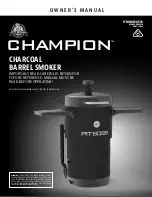
17
carry the smoke away. Installing smoke alarms on both
sides of closed doors and installing more than one smoke
alarm as recommended in this leaflet very significantly
improve the probability of early detection.
• The Smoke Alarm may not be heard.
• Radio link may not work due to interference or the signal
being blocked by furniture, renovations etc.
• A smoke alarm may not wake a person who has taken
drugs or alcohol.
• Smoke Alarms may not detect every type of fire to give
sufficient early warning. They are particularly ineffective
with: fires caused by smoking in bed, escaping gas, violent
explosions. poor storage of flammable rags and/or liquids,
(for example petrol, paint, spirits etc), overloaded electrical
circuits, arson, children playing with matches.
• Smoke Alarms don’t last indefinitely. The manufacturer
recommends replacement after 10 years as a precaution
• Use the Smoke Alarm Test Button to familiarise your family
with the Alarm sound and to practice fire drills regularly with
all family members. Draw up a floor plan that will show each
member at least 2 escape routes from each room in the
house. Children tend to hide when they don’t know what to
do. Teach children how to escape, open windows, and use
roll up fire ladders and stools without adult help. Make sure
they know what to do if the alarm goes off.
10.2 Limitations of Radio Frequency Signals
Ei Electronics radio communication systems are very reliable
and are tested to high standards. However, due to their low
transmitting power and limited range (required by regulatory
bodies) there are some limitations to be considered:
• Receivers may be blocked by radio signals occurring on
or near their operating frequencies, regardless of the house
coding.
• Radio transceiver equipment, such as the Ei3105RF and
the Ei3100RF / Ei3500RF should be tested regularly, at least
weekly. This is to determine, whether there are sources of
interference preventing communication, that the radio paths
have not been disrupted by moving furniture or renovations,
and so generally protect against these and other faults.
The Ei3105RF Transceiver has been tested to EN 300
220-1 V1.3.1 (200-09) in accordance with the requirements
of EN 300 220V1.1.1 (2000-09). These tests are designed to
provide reasonable protection against harmful interference in
residential installations. This equipment generates, uses and
can radiate radio frequency energy and, if not installed and
used in accordance with the instructions, may cause harmful
interference to radio and television reception. However, there
is no guarantee that interference will not occur in a particular
installation. If this device does cause such interference,




































